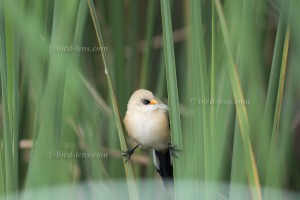 Although the capital of Germany, Berlin has a lot to offer in terms of nature, too. In addition to the natural richness this is a legacy of the division of Germany, which has prevented the city´s spread after the end of the 2nd World War like in no other city. This means, that even today you often have to pass the city limits only in order to stand in the middle of nature. One of these areas is the Nature Park “Lowlands of Nuthe and Nieplitz”. The small rivers Nuthe and Nieplitz are located south-west of Berlin and form a unique lowland habitat. One of the core areas is the Blankensee. The lake is a shallow (only about 60cm deep) water body which is surrounded by an extensive reed belt. Different species of warblers (Acrocephalus sp.), Bluethroat (Luscinia svecica) and Bearded tits – Bearded Reedlings – (Panurus biarmicus) inhabit the edges of the lake. A board walk on the east side of the lake right through the reeds offer a unique observation platform for the keen bird observer. This is especially true in the morning – at sunrise – when, you have an excellent opportunity to experience bird life on almost arm length. Something you should not miss, if you are in the area.
Although the capital of Germany, Berlin has a lot to offer in terms of nature, too. In addition to the natural richness this is a legacy of the division of Germany, which has prevented the city´s spread after the end of the 2nd World War like in no other city. This means, that even today you often have to pass the city limits only in order to stand in the middle of nature. One of these areas is the Nature Park “Lowlands of Nuthe and Nieplitz”. The small rivers Nuthe and Nieplitz are located south-west of Berlin and form a unique lowland habitat. One of the core areas is the Blankensee. The lake is a shallow (only about 60cm deep) water body which is surrounded by an extensive reed belt. Different species of warblers (Acrocephalus sp.), Bluethroat (Luscinia svecica) and Bearded tits – Bearded Reedlings – (Panurus biarmicus) inhabit the edges of the lake. A board walk on the east side of the lake right through the reeds offer a unique observation platform for the keen bird observer. This is especially true in the morning – at sunrise – when, you have an excellent opportunity to experience bird life on almost arm length. Something you should not miss, if you are in the area.
At least, I gave it a try. Maybe I can discover a good bird for the bird-lens.com – portfolio- I was thinking. And the visit in the early morning turned to be successful. One of these species observed was a Little Bittern (Ixobrychus minutus). Already around dawn – very early at around 4:30 – you could clearly hear the muffled sound of the male. Subsequently, bird was clearly identifiable, as it passed me along the reed belt.
Other members of the reed community on Blankensee are the Bearded Tit (Panurus biarmicus). Like the Little Bittern this bird species is a highly specialized reed dweller. Until now I had assumed that the best time for observing the bird, is in winter. Now I could see at least 7 individuals of this species in the middle of summer in mid-July and photograph them very well.
The Bearded Tit lives in extensive reed beds of silt zone nutrient-rich inland waters of all kinds. They live there throughout the year – not just during breeding time. While Eurasian Reed-Warbler (Acrocephalus scirpaceus) and also the larger Great Reed-Warbler (Acrocephalus arundinaceus), live even in small reed areas, the Bearded Tits live only in extended reed beds in front of shallow lake landscapes. Obviously it inhabits no permanent territory, but every flock of the Bearded Tits have several small, alternately frequented home areas. So you can see Bearded Tits flying in small groups between sections in the reeds back. During the flight, you often hear the typical contact calls. So it was on this morning at Blankensee. After a small group was located at the edge of reeds, a little later some individuals could be observed at the edge of the reeds, too. Striking was the rush; the birds never stayed long in one place. Rarely, they stayed once at a blade of grass to sit, poised elegantly on a reed stem or leaf and preen. Bearded Tits are basically diurnal birds. Their activity is highest in the early morning and decreases toward the midday in emerging heat. In this respect, I was probably just at the right time at the right place.
In addition to the Blankensee
Deutschland
Deutschland
In autumn and spring up to 180,000 water birds show up on their resting and gathering areas in the Nature Park. Observation towers on the southern shore of Blankensee and Stangenhagen and the board walks – in addition to the one at Blankensee also on the Riebener Lake – offer excellent chances to birdwatchers to experience the bird life.
In order to meet the growing demand for top images of the rarer species of Palaearctic Bird-lens.com has specifically made trips to remote places like the coastal mountains of western Norway, in the winter to a secluded harbor in Denmark, or – right now – to the outskirts of Berlin. This to do everything to ensure excellent photos of the Birds of the Western Palearctic . The yield of pictures also of rare Western Palaearctic birds is very good. The nice picture you see in blog is just a first impression of what you will find behind the tab “Picture- Store” very soon. Just give a notice if you need a picture of a bird before the new images are online.